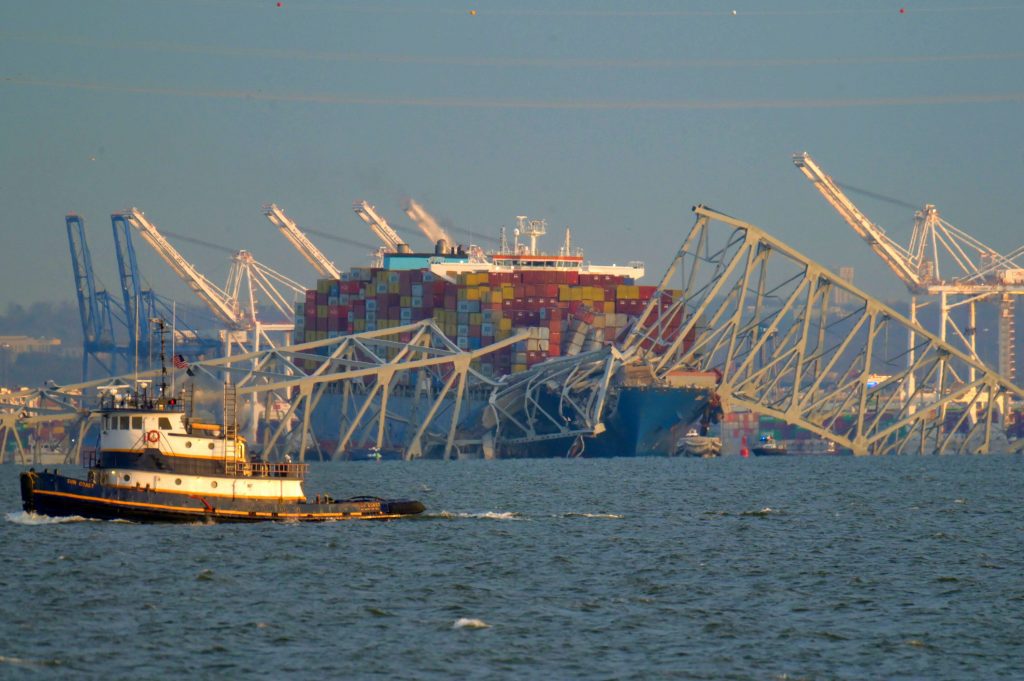Ethan M Steinberg, Chris Dolmetsch, Matthew Griffin | Bloomberg News (TNS)
The owner of the ship that crashed into a Baltimore bridge may have to pay hundreds of millions of dollars in damage claims after the accident caused vehicles to fall into the water and disrupted the eastern U.S. transportation network.
Legal experts believe there is a way to reduce the liability using a 19th-century law that the owner of the Titanic used to limit its payout for the 1912 sinking.
The main focus of the legal aftermath will be Grace Ocean, the owner of the container ship Dali that collided with the Francis Scott Key Bridge at the beginning of a journey chartered by the shipping giant Maersk.
Stationary objects
The company may be sued from different sources, including the bridge’s owner and the families of six workers who were presumed dead after a search in the Patapsco River.
According to Michael Sturley, a maritime law expert at the University of Texas at Austin’s School of Law, damages claims are likely to be directed at the ship owner rather than the agency that operates the bridge, as stationary objects are not typically at fault if a moving vessel hits them.
However, an 1851 law could reduce the exposure to tens of millions of dollars by capping the ship owner’s liability at the value of the vessel after the crash, plus any earnings from carrying the freight on board, according to Martin Davies, the director of Tulane University’s Maritime Law Center.
The law was established to prevent shipping companies from suffering huge losses from disasters at sea. Although still substantial, an eight-figure sum would be significantly less than the total claims, Davies explained.
‘Very unusual’
Martin Davies said, “It’s a very unusual casualty in one respect, especially because of the footage showing the entire bridge collapsing. But in many ways, it’s not unusual, since ships collide and cause damage and injuries all the time.”
Lawrence B. Brennan, a professor at Fordham University School of Law, expects the Dali’s operator to initiate a process in the U.S. under the 1851 law, which was referenced by the Titanic’s owner in a Supreme Court case over a century ago.
The ship owner’s insurance would assist them in managing the legal risks. About 90% of the world’s ocean-bound cargo is insured by a division of the International Group of Protection and Indemnity Clubs, which oversees the 12 major mutual insurance associations for ship owners.
Proving whether the accident resulted from negligence, and if so, by whom, or from mechanical failure, will be crucial in determining any insurance claims, as stated by Bloomberg Intelligence. The ship is insured by the Britannia Protection and Indemnity Club, which is a mutual insurance association owned by shipping companies and is part of the International Group of P&I Clubs.
According to Bloomberg Intelligence analysts Matthew Palazola and Charles Graham, the policies related to the Dali have a total insured limit of about $3 billion, a substantial amount but one that “would be very manageable for the global reinsurance market.”
Britannia P&I stated that they are working closely with the ship manager and relevant authorities to find out the facts and ensure that this situation is dealt with quickly and professionally.
Bloomberg Intelligence also mentioned that Maersk might not be responsible because the Danish company had no crew on board and the ship was operated by a charter company.
Stephane Kovatchev, a credit analyst with Bloomberg Intelligence, said that maritime insurance will probably cover some of the costs. However, uncertainty about the total liabilities and who will pay for them will likely affect Maersk’s spreads in the near term.
U.S. Constitution
According to Charles A. Patrizia, who heads an American Bar Association committee on marine law, while federal courts have authority over maritime disputes, individuals affected by the bridge strike could potentially pursue damages under a clause of the U.S. Constitution that permits those injured in accidents at sea or with property claims to file lawsuits in state court.
In such situations, businesses often file claims for interruption, asserting economic losses. However, those claims are usually unsuccessful due to a law that mainly restricts the compensation of money damages to individuals who were physically injured, as mentioned by Sturley, the UT Austin professor.
And what will happen to the ship itself, which has been managed for Grace Ocean by Singapore-based Synergy Marine Group?
The owner of the ship may want to remove it from the U.S., but the Maryland Transportation Authority will likely attempt to keep it under “arrest” while it pursues claims – and possibly until damages are resolved, according to Brennan, the Fordham professor.
He mentioned, “The ship won’t be moving for a while.”
(With assistance from David Voreacos and Laura Benitez.)
©2024 Bloomberg L.P. Visit bloomberg.com. Distributed by Tribune Content Agency, LLC.









